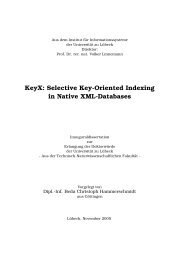Gesture-Based Interaction with Time-of-Flight Cameras
Gesture-Based Interaction with Time-of-Flight Cameras
Gesture-Based Interaction with Time-of-Flight Cameras
Create successful ePaper yourself
Turn your PDF publications into a flip-book with our unique Google optimized e-Paper software.
additive terms to obtain an energy function<br />
E(R, A) = ∑<br />
j<br />
∑<br />
j<br />
(XR j<br />
2 σ2 R<br />
− Rj) 2<br />
+<br />
(X I j − Ij(R, A)) 2<br />
2 σ 2 I<br />
E R (R) + E A (A),<br />
+<br />
4.2. METHOD<br />
✞ ☎<br />
✝4.7<br />
✆<br />
where the index j runs over all pixels. (For the “fixed albedo” and “global albedo”<br />
models, the term E A (A) is omitted.) Note that all the terms in the energy function<br />
are unitless due to multiplication or division by the constants σR, σI, wR and wA.<br />
We find the maximum a posteriori estimate for the range map by minimizing<br />
E(R, A) using the Polak-Ribière variant <strong>of</strong> the nonlinear conjugate gradient algo-<br />
rithm (see for example (Press et al., 1992)). As the starting point for the minimiza-<br />
tion, we use the observed range map X R , smoothed using a median filter, and an<br />
albedo guess (see Section 4.2.4). The gradient <strong>of</strong> E(R, A) is computed numerically<br />
using a finite differences approximation. The parameters σR, σI, wR and wA should<br />
be set to reflect the noise characteristics <strong>of</strong> the sensor and the statistical properties<br />
<strong>of</strong> the scene.<br />
4.2.2 Lambertian Reflectance Model<br />
Under the Lambertian model <strong>of</strong> diffuse reflection (Trucco and Verri, 1998), the in-<br />
tensity I <strong>with</strong> which a point on an object appears in the image is obtained as follows:<br />
I = a<br />
n · l<br />
,<br />
r2 ✞ ☎<br />
✝4.8<br />
✆<br />
where n is the surface normal, l is the unit vector from the surface point towards<br />
the light source, r is the distance <strong>of</strong> the surface point to the light source, and a is a<br />
constant that depends on the albedo <strong>of</strong> the surface, the intensity <strong>of</strong> the light source,<br />
and properties <strong>of</strong> the camera such as aperture and exposure time. For brevity, we<br />
will refer to a simply as the albedo, because any changes to a across the scene are<br />
due to albedo changes, while the properties <strong>of</strong> the light source and camera remain<br />
constant.<br />
On a TOF camera, the light source can be assumed to be co-located <strong>with</strong> the<br />
camera, and so r is simply the range value for the surface point, and l is the unit<br />
vector from the surface point to the camera.<br />
37

















